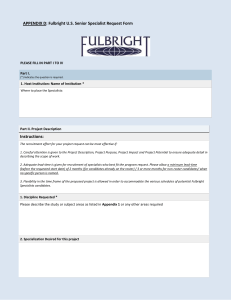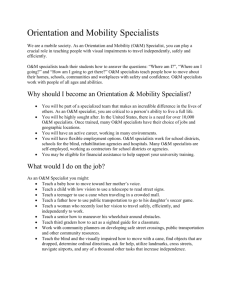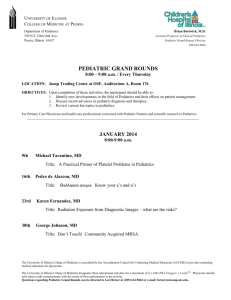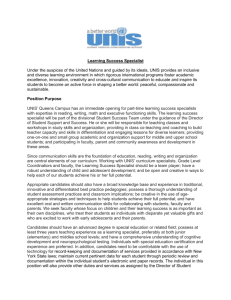Annotated Bibliography - Michigan State University
advertisement
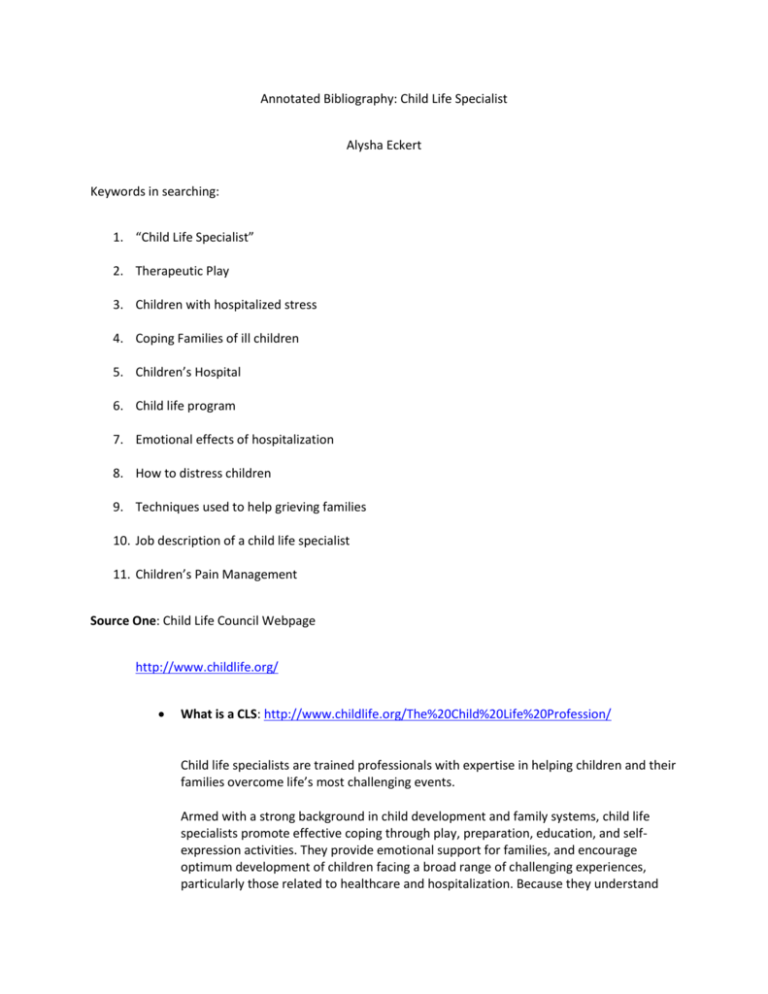
Annotated Bibliography: Child Life Specialist Alysha Eckert Keywords in searching: 1. “Child Life Specialist” 2. Therapeutic Play 3. Children with hospitalized stress 4. Coping Families of ill children 5. Children’s Hospital 6. Child life program 7. Emotional effects of hospitalization 8. How to distress children 9. Techniques used to help grieving families 10. Job description of a child life specialist 11. Children’s Pain Management Source One: Child Life Council Webpage http://www.childlife.org/ What is a CLS: http://www.childlife.org/The%20Child%20Life%20Profession/ Child life specialists are trained professionals with expertise in helping children and their families overcome life’s most challenging events. Armed with a strong background in child development and family systems, child life specialists promote effective coping through play, preparation, education, and selfexpression activities. They provide emotional support for families, and encourage optimum development of children facing a broad range of challenging experiences, particularly those related to healthcare and hospitalization. Because they understand that a child’s wellbeing depends on the support of the family, child life specialists provide information, support and guidance to parents, siblings, and other family members. They also play a vital role in educating caregivers, administrators, and the general public about the needs of children under stress. What do they do? http://www.childlife.org/The%20Child%20Life%20Profession/HowaChildLifeSpecialistCa nHelpYou.cfm The American Academy of Pediatrics affirms that child life is “an essential component of quality pediatric health care,”1 and as such, child life services have become a standard in most pediatric hospital settings. Child life specialists typically work as members of an interdisciplinary team, which may include physicians, nurses, social workers, therapists, counselors, teachers, parents and others. Child life specialists focus on the psychosocial needs of children, collaborating with parents and other members of the team to: Ease a child’s fear and anxiety with therapeutic and recreational play activities Foster an environment that incorporates emotional support Encourage understanding and cooperation by providing non-medical preparation and support for children undergoing tests, surgeries, and other medical procedures Advocate for family-centered care Engage and energize children and families by coordinating special events, entertainment, and activities Consider the needs of siblings or other children who may also affected by a child’s illness or trauma Direct pre-admission hospital tours and resources, and consultations with outpatient families Support families confronting grief and bereavement issues Provide information and resources for parents and members of the interdisciplinary team Needs/Statements/References about CLS: http://www.childlife.org/The%20Child%20Life%20Profession/CaseforChildLife.cfm -Views from Academy of pediatrics, Psychosocial and evidence-based practices Missions, Values, and Vision: http://www.childlife.org/The%20Child%20Life%20Profession/ProfessionMissionVisionV aluesPositionStatements.cfm What they should do and value as CLS. Vision statement and standards of CLS. History: http://www.childlife.org/The%20Child%20Life%20Profession/HistoryoftheProfession.cf m -history of child life program http://www.childlife.org/The%20Child%20Life%20Profession/Timeline.cfm -timeline of child life program/specialists Source Two: Child Life Services (Statistical Data Included). Source:Pediatrics 106.5 (Nov 2000): p1156. (2632 words) Document Type:Magazine/Journal Source Citation:"Child Life Services." Pediatrics 106.5 (Nov 2000): 1156. Expanded Academic ASAP. Gale. Michigan State University Libraries. 19 Mar. 2009 <http://find.galegroup.com/itx/start.do?prodId=EAIM>. Gale Document Number:A67442729 “Abstract: Child life programs have become the standard in large pediatric settings to address the psychosocial concerns that accompany hospitalization and other health care experiences. Child life programs facilitate coping and the adjustment of children and families in 3 primary service areas: 1) providing play experiences; 2) presenting developmentally appropriate information about events and procedures; and 3) establishing therapeutic relationships with children and parents to support family involvement in each child's care. Although other members of the health care team share these responsibilities for the psychosocial concerns of the child and the family, for the child life specialist, this is the primary role. The child life specialist focuses on the strengths and sense of well-being of children while promoting their optimal development and minimizing the adverse effects of children's experiences in a hospital setting.” This article explains each component of a child life’s responsibilities and daily routines with patients. It gives detail on how many patients per specialist there are. Article is very descriptive in the duties that must be performed. Source Three: Child Life Specialists: Making the Tough Times a Little Easier By: Cinda McDonald Source: The Exceptional Parent 31 no 7 80-4 J1 2001 pg. 80-84 http://rpproxy.iii.com:9797/MuseSessionID=c9a3fbf31e80ec4b3e883aab54192941/MuseHost=f irstsearch.oclc.org/MusePath/WebZ/FSFETCH?fetchtype=fullrecord:sessionid=fsapp4-57745-fsi1whn3tzr0nu:entitypagenum=5:0:recno=3:resultset=1:format=FI:next=html/record.html:bad=error/badfetch.h tml:entitytoprecno=3:entitycurrecno=3:numrecs=1 -Great source for detail. Goes into depth on what actually happens and is going on during admission and preparation for surgery. Definitely use this source. Source Four: Pediatric Anxiety: Child Life Intervention in Day Surgery Journal of Pediatric Nursing, Volume 21, Issue 1, Pages 13-22 S. Brewer, S. Gleditsch, D. Syblik, M. Tietjens, H. Vacik Abstract: Although many hospitals offer a surgical preparation program to children and families, minimal research has been conducted specifically on preparation by child life specialists. The purpose of this double-blind intervention study was to determine if children prepared for day surgery by a child life specialist exhibited less anxiety than those who received routine standard of care. One hundred forty-two children, aged between 5 and 11 years old, undergoing elective otolaryngology surgery completed the study. The “Child Drawing: Hospital” instrument developed by Clatworthy, Simon, and Tiedeman [Clatworthy, S., Simon, K., & Tiedeman, M. E. (1999). Child Drawing: Hospital – An instrument designed to measure the emotional status of hospitalized school-aged children. Journal of Pediatric Nursing, 14, 2–9] was used to determine children's anxiety levels preintervention and postintervention. Eighty children received formal preparation for their surgeries by a child life specialist and 62 received no intervention. The data were analyzed using a repeated-measures model with intervention, age, sex, and level of surgery for main effects. The anxiety score change was significantly better for the patients in the child life intervention group than for those in the nonintervention group, F(1,135) = 4.24, p = .04. The increase in anxiety scores in the nonintervention group suggests that children could benefit from preoperative preparation. Health professionals, including nurses, may impact children's abilities to cope with a surgical process. The information in this study will be useful in deciding whether all children, not just those with a perceived need, should be prepared prior to an elective day surgery. Source Five: Child Life Council and Committee on Hospital Care PEDIATRICS Vol. 118 No. 4 October 2006, pp. 1757-1763 (doi:10.1542/peds.2006-1941) Does really well at explaining child life and is separated into sections. Also it gives services and recommendations. Source Six: To be recorded later. Certified Child Life Specialist from Mott Children’s Hospital Source Seven: To be recorded later. Patient/family at Mott Children’s Hospital


